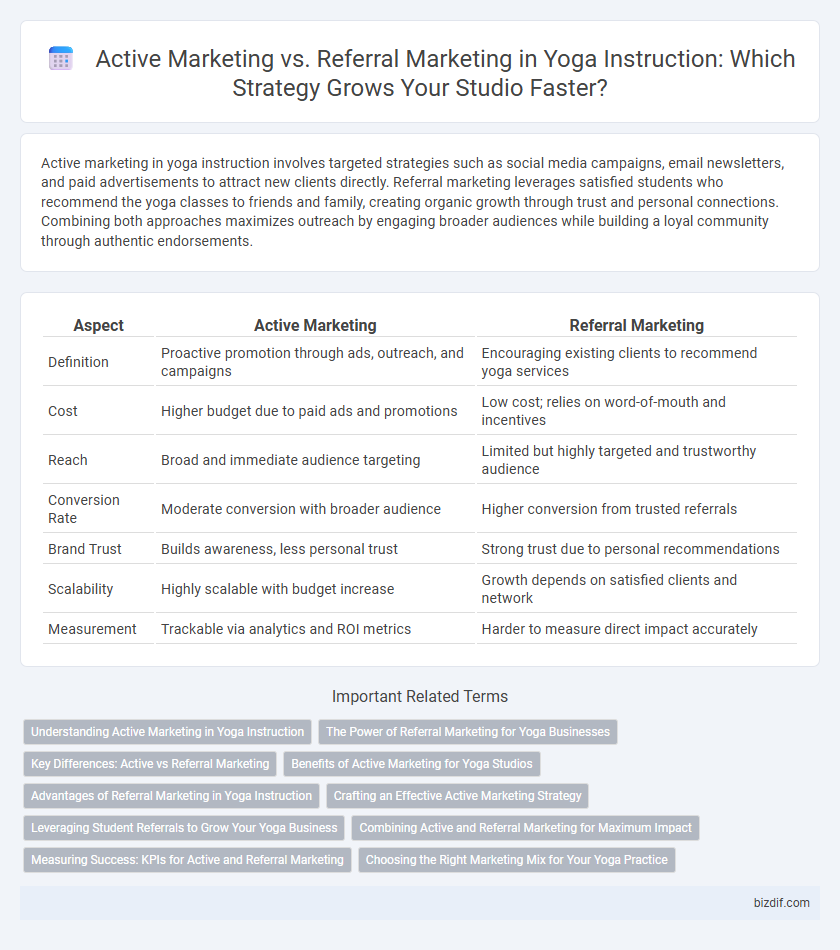Active marketing in yoga instruction involves targeted strategies such as social media campaigns, email newsletters, and paid advertisements to attract new clients directly. Referral marketing leverages satisfied students who recommend the yoga classes to friends and family, creating organic growth through trust and personal connections. Combining both approaches maximizes outreach by engaging broader audiences while building a loyal community through authentic endorsements.
Table of Comparison
| Aspect | Active Marketing | Referral Marketing |
|---|---|---|
| Definition | Proactive promotion through ads, outreach, and campaigns | Encouraging existing clients to recommend yoga services |
| Cost | Higher budget due to paid ads and promotions | Low cost; relies on word-of-mouth and incentives |
| Reach | Broad and immediate audience targeting | Limited but highly targeted and trustworthy audience |
| Conversion Rate | Moderate conversion with broader audience | Higher conversion from trusted referrals |
| Brand Trust | Builds awareness, less personal trust | Strong trust due to personal recommendations |
| Scalability | Highly scalable with budget increase | Growth depends on satisfied clients and network |
| Measurement | Trackable via analytics and ROI metrics | Harder to measure direct impact accurately |
Understanding Active Marketing in Yoga Instruction
Active marketing in yoga instruction involves proactive strategies such as hosting workshops, creating engaging social media content, and running targeted advertising campaigns to attract new students. This approach leverages direct communication and consistent brand presence to build awareness and showcase unique teaching styles. Using email marketing and online class promotions further enhances visibility and enrollment rates in competitive yoga markets.
The Power of Referral Marketing for Yoga Businesses
Referral marketing drives substantial growth for yoga businesses by leveraging the trust and personal connections between existing clients and potential new customers. Unlike active marketing strategies that require continuous outreach and advertising spend, referral marketing builds organic momentum through satisfied practitioners who share their positive experiences. This approach enhances client retention, increases lifetime value, and generates high-quality leads with minimal cost, making it a powerful tool for sustainable yoga business expansion.
Key Differences: Active vs Referral Marketing
Active marketing in yoga instruction involves direct outreach methods such as social media campaigns, email newsletters, and paid advertisements to attract new students. Referral marketing relies on existing clients recommending the yoga instructor to friends and family, leveraging trust and personal endorsements. Key differences include the immediacy and control of active marketing efforts versus the organic, trust-based growth driven by referral marketing.
Benefits of Active Marketing for Yoga Studios
Active marketing for yoga studios drives immediate visibility through targeted social media campaigns, local events, and paid advertisements, attracting a broader, diverse clientele beyond current networks. It enables precise tracking of marketing performance via analytics, allowing studios to optimize strategies and boost enrollment rates efficiently. This proactive approach builds brand awareness and establishes a strong community presence, accelerating business growth faster than relying solely on referral marketing.
Advantages of Referral Marketing in Yoga Instruction
Referral marketing in yoga instruction leverages trust and personal connections, leading to higher client retention and authentic word-of-mouth promotion. This method reduces marketing costs by utilizing satisfied students as advocates, enhancing credibility and attracting like-minded individuals. Yoga studios benefit from enhanced community engagement and organic growth through targeted referral incentives.
Crafting an Effective Active Marketing Strategy
Crafting an effective active marketing strategy for yoga instruction involves targeting specific demographics through social media campaigns, SEO optimization, and engaging content that highlights class benefits and instructor expertise. Leveraging platforms like Instagram and Facebook enables personalized promotions and timely communication, driving enrollment growth. Tracking engagement metrics and adjusting ad spend in real-time ensures maximum return on investment and sustained student acquisition.
Leveraging Student Referrals to Grow Your Yoga Business
Leveraging student referrals in yoga instruction significantly enhances client acquisition by harnessing trust and personal recommendations. Active marketing requires ongoing outreach efforts, while referral marketing capitalizes on satisfied students sharing their positive experiences, driving organic growth. Prioritizing referral incentives and creating a community atmosphere encourages word-of-mouth promotion, resulting in higher retention rates and expanded student base.
Combining Active and Referral Marketing for Maximum Impact
Combining active marketing and referral marketing in yoga instruction leverages direct outreach through social media ads and email campaigns with the trust-based power of client referrals, resulting in enhanced brand visibility and client acquisition. Active marketing drives immediate attention and broad reach, while referral marketing builds credibility and long-term loyalty through personal endorsements. Integrating both strategies maximizes enrollment rates and fosters a sustainable community of engaged yoga practitioners.
Measuring Success: KPIs for Active and Referral Marketing
Active marketing success in yoga instruction can be measured by KPIs such as click-through rates, conversion rates, and cost per acquisition from campaigns targeting new clients. Referral marketing KPIs focus on customer lifetime value, referral rate, and net promoter score to gauge client satisfaction and word-of-mouth effectiveness. Comparing these metrics helps yoga instructors allocate resources effectively between direct outreach and leveraging existing client networks.
Choosing the Right Marketing Mix for Your Yoga Practice
Active marketing for yoga instruction involves targeted strategies such as social media campaigns, email newsletters, and pay-per-click advertising to attract new students and build brand awareness. Referral marketing leverages satisfied clients to generate word-of-mouth recommendations, enhancing trust and improving client retention through personal endorsements. Combining data-driven active marketing techniques with the authentic outreach of referral marketing creates a balanced marketing mix that maximizes student acquisition and sustains long-term growth in a competitive yoga practice market.
Active marketing vs Referral marketing Infographic

 bizdif.com
bizdif.com